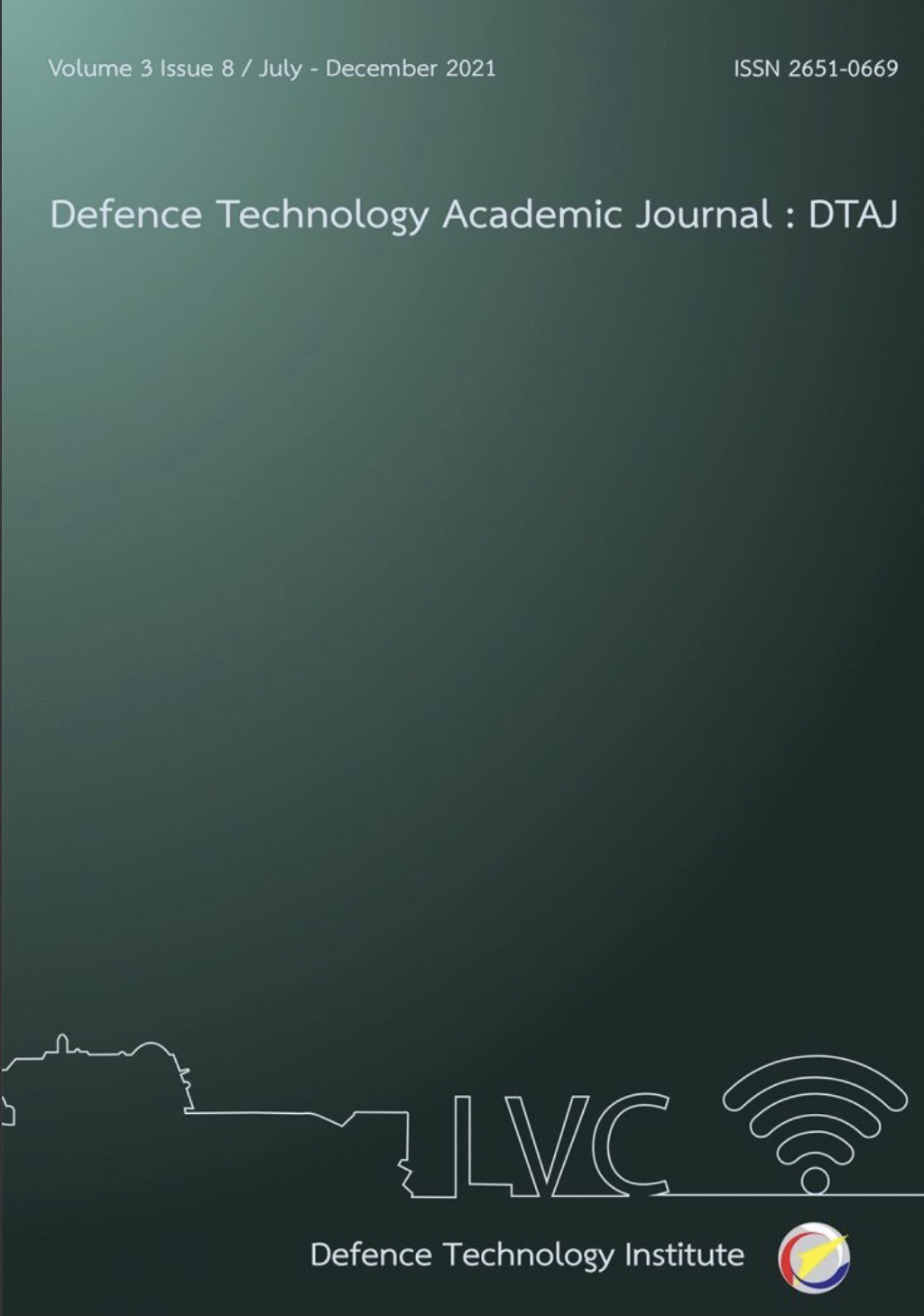Flood Risk Assessment using Analytical Hierarchy Process and Geographic Information Systems
Main Article Content
Abstract
Floods are natural disasters that damage lives and properties. This academic paper aims to review the literature on geospatial technology, introduction to geographical quantitative methods for analysis of factors affecting flooding in Pua Subdistrict, Pua District, Nan province. The research method was based on factor analysis using an analytical hierarchy process (AHP) model which the flood disaster experts rate the factor weight and land and building information survey. The results of the study revealed that there were 6 factors affecting flood risk consist of rainfall, slope, elevation, land use, and soil series respectively. Local government officials or disaster prevention and mitigation agencies can apply the principles of this study to more precisely and accurate assess areas at risk of future flooding.
Downloads
Article Details

This work is licensed under a Creative Commons Attribution-NonCommercial-NoDerivatives 4.0 International License.
Journal of TCI is licensed under a Creative Commons Attribution-NonCommercial-NoDerivatives 4.0 International (CC BY-NC-ND 4.0) licence, unless otherwise stated. Please read our Policies page for more information...
References
Rotjanakusol, T. & Laosuwan, T. 2018 Inundation area investigation approach using remote sensing technology on 2017 flooding in Sakon Nakhon province Thailand”. Studia Universitatis Vasile Goldis Arad, Seria Stiintele Vietii, 28(4), 159-166.
Milly, P.C., Wetherald, R.T., Dunne, K.A., & Delworth, T.L. 2002. Increasing Risk of Great Floods in a Changing Climate. Nature. 15(6871), 514-517.
Department of Disaster Prevention and Mitigation. Ministry of Interior. Thailand. 2013. Report Analysis/Monitoring. Retrieved from www.disaster.go.th/th/dwn-down26 วารสารวิชาการเทคโนโลยีป้องกันประเทศปีที่ 3 ฉบับที่ 8 / กรกฎาคม - ธันวาคม 2564 load-12-1/ (in Thai)
Asian Disaster Reduction Center. 2012. Natural Disaster Data Book. Asian Disaster Reduction Center (ADRC).
Blanc, J., Hall, J., Roche, N., Dawson, R., Cesses, Y., Burton, A., & Kilsby, C. 2012. Enhanced efficiency of pluvial flood risk estimation in urban areas using spatial– temporal rainfall simulations. Journal of Flood Risk Management, 5, 143–152.
Kim, B., Sanders, B.F., Schubert, J.E., & Famiglietti, J.S. 2014. Mesh type tradeoffs in 2D hydrodynamic modeling of flooding with a Godunov-based flow solver. Advances in Water Resources, 68, 42-61.
Elkhrachy, I. 2015. Flash Flood Hazard Mapping Using Satellite Images and GIS Tools: A case study of Najran City, Kingdom of Saudi Arabia (KSA). The Egyptian Journal of Remote Sensing and Space Science, 18(2), 261-278.
นาถนเรศ อาคาสุวรรณ, ประมาณ เทพสงเคราะห์, และ วรุฒน์ นาที. 2552. การศึกษาปัจจัยการเกิดน้ำท่วมเพื่อกำหนดพื้นที่เสี่ยงภัยน้ำท่วมด้วยระบบสารสนเทศภูมิศาสตร์และแนวทางป้องกันบรรเทาในบริเวณลุ่มน้ำย่อยทะเลสาบสงขลาฝั่งตะวันตก จังหวัดพัทลุง. มหาบัณฑิต ศศ.ม. (พื้นที่ศึกษา). บัณฑิตวิทยาลัย/มหาวิทยาลัยทักษิณ. เอกสารอิเล็กทรอนิกส์.
มยุรมาศ ปุ่นสกุล. 2545. การวิเคราะห์สภาพพื้นที่เสี่ยงอุทกภัยและสภาวะการรับรู้ของประชาชน กรณีศึกษา ตำบลวังบาล อำเภอหล่มเก่า จังหวัดเพชรบูรณ์. ปริญญานิพนธ์ วท.บ. (ภูมิศาสตร์). บัณฑิตวิทยาลัย มหาวิทยาลัยเชียงใหม่. เอกสารอิเล็กทรอนิกส์.
เพ็ชรสวัสดิ์ กันคำ. 2547. การประยุกต์ใช้สารสนเทศภูมิศาสตร์เพื่อวิเคราะห์พื้นที่เสี่ยงต่อการเกิดอุทกภัยในเขตลุ่มน้ำแม่กวง. ปริญญานิพนธ์ วท.บ. (ภูมิสาสตร์). บัณฑิตวิทยาลัย มหาวิทยาลัยเชียงใหม่. เอกสารอิเล็กทรนิกส์.
Samarasinghe., S.M.J.S. 2010. Application of remote sensing and GIS for flood risk analysis: A case study at KALU-GANGA river, Sri Lanka. Survey Department. Kyoto Japan. Electronic records.
Official Statistics Registration System, Thailand. 2553. Retrieved from http://service.nso.go.th/nso/nsopublish/districtList/page1.htm (in Thai)
Fundamental Geographic Data Set (FGDS). 2556. Retrieved from www.ngis.go.th/home/wp-content/uploads/2019/03/FundamentalGeographicDataSet_FGDS.pdf (in Thai)
ไพศาล จี้ฟู 2561. การพัฒนาโปรแกรมประยุกต์สำหรับระบบสารสนเทศภูมิศาสตร์บนเว็บ (Application Development for Web-based GIS), พิมพ์ครั้งที่ 1 จำนวน 500 เล่ม, สำนักพิมพ์จุฬาลงกรณ์มหาวิทยาลัย, ISBN : 9789740337508.
สุเพชร จิรขจรกุล. 2552. เรียนรู้ระบบภูมิสารสนเทศด้วยโปรแกรม ArcGIS Desktop 9.3.1 (พิมพ์ครั้งที่ 1). นนทบุรี: บริษัท เอส.อาร์ พริ้นติ้งแมสโปรดักส์ จำกัด.
สัญญา สราภิรมย์. 2549. เอกสารประกอบการสอนวิชาระบบสารสนเทศภูมิศาสตร์ (106611). นครราชสีมา: สาขาการรับรู้ระยะไกล สำนักวิชาวิทยาศาสตร์ มหาวิทยาลัยเทคโนโลยีสุรนารี
สรรค์ใจ กลิ่นดาว. 2542. ระบบสารสนเทศภูมิศาสตร์: หลักการเบื้องต้น (พิมพ์ครั้งที่ 2). กรุงเทพฯ: มหาวิทยาลัยธรรมศาสตร์.
ประเสริฐ วิทยารัฐ. 2530. สถิติทางภูมิศาสตร์. กรุงเทพฯ: อักษรบัณฑิต.
Saaty, T.L. 1980. The analytical hierarchy process, New York: McGraw-Hill.
เผ่าไท ถายะพิงค์ และปิยะวรรณ สุทธิประพันธ์. 2558. การประยุกต์ใช้เทคโนโลยีภูมิสารสนเทศในการศึกษาความหลากหลายชนิดและการแพร่กระจายของแมลงศัตรูกาแฟอราบิกาในจังหวัดเชียงใหม่และเชียงราย. วารสารเกษตร 31(2), 203-213.
Jeefoo., P. 2012. Space-Time Analysis Tools of Dengue Epidemics in Chachoengsao Province, Thailand. International Journal of Geoinformatics, 8(3), 9-13.
Jeefoo, P. 2020. A webGIS base information system for monitoring wildfire using Suomi-NPP (VIIR) satellite in Phare province, Thailand. Naresuan University Journal: Science and Technology, 28(2), 62-71.
Jeefoo, P. 2019. Wildfire field survey using mobile GIS technology in Nan province. The 4th International Conference on Digital Arts, Media and Technology and 2nd ECTI Northern Section Conference on Electrical, Electronics, Computer and Telecommunications Engineering, Nan, Thailand, 98-100.


